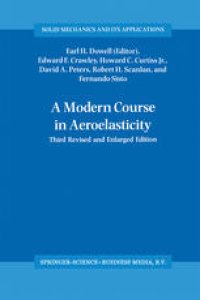
Ebook: A Modern Course in Aeroelasticity
- Tags: Automotive Engineering, Mechanics, Mechanical Engineering
- Series: Solid Mechanics and its Applications 32
- Year: 1995
- Publisher: Springer Netherlands
- Edition: 3
- Language: English
- pdf
Aeroelasticity is the study of flexible structures situated in a flowing fluid. Its modern origins are in the field of aerospace engineering, but it has now expanded to include phenomena arising in other fields such as bioengineering, civil engineering, mechanical engineering and nuclear engineering. The present volume is a teaching text for a first, and possibly second, course in aeroelasticity. It will also be useful as a reference source on the fundamentals of the subject for practitioners. In this third edition, several chapters have been revised and three new chapters added. The latter include a brief introduction to `Experimental Aeroelasticity', an overview of a frontier of research `Nonlinear Aeroelasticity', and the first connected, authoritative account of `Aeroelastic Control' in book form.
The authors are drawn from a range of fields including aerospace engineering, civil engineering, mechanical engineering, rotorcraft and turbomachinery. Each author is a leading expert in the subject of his chapter and has many years of experience in consulting, research and teaching.
Aeroelasticity is the study of flexible structures situated in a flowing fluid. Its modern origins are in the field of aerospace engineering, but it has now expanded to include phenomena arising in other fields such as bioengineering, civil engineering, mechanical engineering and nuclear engineering. The present volume is a teaching text for a first, and possibly second, course in aeroelasticity. It will also be useful as a reference source on the fundamentals of the subject for practitioners. In this third edition, several chapters have been revised and three new chapters added. The latter include a brief introduction to `Experimental Aeroelasticity', an overview of a frontier of research `Nonlinear Aeroelasticity', and the first connected, authoritative account of `Aeroelastic Control' in book form.
The authors are drawn from a range of fields including aerospace engineering, civil engineering, mechanical engineering, rotorcraft and turbomachinery. Each author is a leading expert in the subject of his chapter and has many years of experience in consulting, research and teaching.
Aeroelasticity is the study of flexible structures situated in a flowing fluid. Its modern origins are in the field of aerospace engineering, but it has now expanded to include phenomena arising in other fields such as bioengineering, civil engineering, mechanical engineering and nuclear engineering. The present volume is a teaching text for a first, and possibly second, course in aeroelasticity. It will also be useful as a reference source on the fundamentals of the subject for practitioners. In this third edition, several chapters have been revised and three new chapters added. The latter include a brief introduction to `Experimental Aeroelasticity', an overview of a frontier of research `Nonlinear Aeroelasticity', and the first connected, authoritative account of `Aeroelastic Control' in book form.
The authors are drawn from a range of fields including aerospace engineering, civil engineering, mechanical engineering, rotorcraft and turbomachinery. Each author is a leading expert in the subject of his chapter and has many years of experience in consulting, research and teaching.
Content:
Front Matter....Pages i-xxiii
Introduction....Pages 1-2
Static aeroelasticity....Pages 3-53
Dynamic aeroelasticity....Pages 54-166
Nonsteady aerodynamics of lifting and non-lifting surfaces....Pages 167-274
Stall flutter....Pages 275-296
Aeroelastic problems of civil engineering structures....Pages 297-369
Aeroelastic response of rotorcraft....Pages 370-437
Aeroelasticity in turbomachines....Pages 438-471
Unsteady transonic aerodynamics and aeroelasticity....Pages 472-532
Experimental aeroelasticity....Pages 533-541
Nonlinear aeroelasticity....Pages 542-572
Aeroelastic control....Pages 573-652
Back Matter....Pages 653-703
Aeroelasticity is the study of flexible structures situated in a flowing fluid. Its modern origins are in the field of aerospace engineering, but it has now expanded to include phenomena arising in other fields such as bioengineering, civil engineering, mechanical engineering and nuclear engineering. The present volume is a teaching text for a first, and possibly second, course in aeroelasticity. It will also be useful as a reference source on the fundamentals of the subject for practitioners. In this third edition, several chapters have been revised and three new chapters added. The latter include a brief introduction to `Experimental Aeroelasticity', an overview of a frontier of research `Nonlinear Aeroelasticity', and the first connected, authoritative account of `Aeroelastic Control' in book form.
The authors are drawn from a range of fields including aerospace engineering, civil engineering, mechanical engineering, rotorcraft and turbomachinery. Each author is a leading expert in the subject of his chapter and has many years of experience in consulting, research and teaching.
Content:
Front Matter....Pages i-xxiii
Introduction....Pages 1-2
Static aeroelasticity....Pages 3-53
Dynamic aeroelasticity....Pages 54-166
Nonsteady aerodynamics of lifting and non-lifting surfaces....Pages 167-274
Stall flutter....Pages 275-296
Aeroelastic problems of civil engineering structures....Pages 297-369
Aeroelastic response of rotorcraft....Pages 370-437
Aeroelasticity in turbomachines....Pages 438-471
Unsteady transonic aerodynamics and aeroelasticity....Pages 472-532
Experimental aeroelasticity....Pages 533-541
Nonlinear aeroelasticity....Pages 542-572
Aeroelastic control....Pages 573-652
Back Matter....Pages 653-703
....